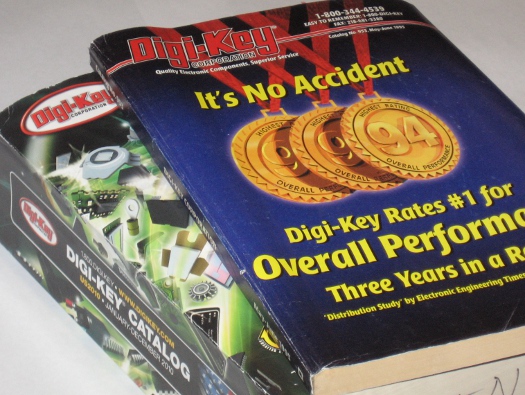Digi-Key Catalog – then and now – 1995 and 2010. It’s good to see the cheesy slogans haven’t gone away!
Digi-Key has come a long way since 1995, from 13mm to 67mm to be precise. But like all things, it must inevitably come to an end. It was announced earlier this year that Digi-Key was no longer going to be mailing out paper catalogs. And although i applaud their environmental statement (which is probably just an economic statement), i will miss the best bathroom reading an engineer could have. Many times i have found an interesting part that i never knew existed, by just perusing the pages of this catalog. I’m currently using a multi-axis, micro-power, RFID wake-up chip i discovered this way.
So, what has changed in those extra 54mm of catalog we’ve gained in the past 15 years? As it turns out, not too much. The same basic parts are there, but just more of them. All of the same sections are mostly there, with the addition of the RF and sensors sections. The number of parts in these sections approximately doubled, except for connectors and integrated circuits, which easily went ten-fold. These two sections now account for about half of the catalog. The 1995 catalog didn’t even have TI parts, and the only microcontrollers were a handful of PICs and a basic stamp.
Fortunately, the pricing hasn’t inflated with the number of pages. A 0.1″ header is still 0.53$ for a 10p strip. In general the passives and electromechanical parts are the same prices, with ICs mostly dropping in half. The 74HC14, for example, went from 0.81$ to 0.42$. LEDs were 0.43$ back in the day, and an LM339 was 1.20$. Oddly enough, the 7805 has gone up in price, from 0.53$ to 0.76$.
What i miss most about the old Digi-Key, is the odd chip here or there that did everything you needed. The 1995 catalog carried Panasonic bucket-brigade devices, the LM1496 (poor-man’s multiplier), and the ICL8038 function generator. A lot of these, like the CA3080 OTA are no longer in production, but many are just not carried due to low demand.
It’s interesting to note the beginnings of Digi-Key. According to the blurb on their website:
“Digi-Key Corporation got its start in 1972 when Dr. Ron Stordahl, a young electrical engineer working toward his doctoral degree, had the idea to package electronic parts in small quantities and market them to fellow electronics enthusiasts. With a modest inventory, Stordahl’s marketing plan comprised advertising Digi-Key’s one-page, typewritten and mimeographed “catalog” in publications geared toward hobbyists. A simple business principle was the foundation of his fledgling business – to provide customers the best possible service.”
I’m sure this sounds pretty familiar to many of the current hacker suppliers. It makes me wonder where they will all be in another 15 years. Will the Mouser/Digi-Key catalog wars of the early 2000′s get played out by a new generation of actors? Will we see a Sparkfun catalog thick enough to be used as high voltage insulation? Perhaps Adafruit will be chocked so full of Arduino shields that you won’t be able to find the one you need? In which case, i’m sure the next generation will step up to start their own hacker supply revolution.
In the meantime, be sure to call Digi-Key and order your catalog, as it really is the only decent way to find connectors. Perhaps they will continue a ‘connector only’ version.

One Comment
Oh wow! I didn’t know they are cutting out the giant catalogues. The paper mill will be a relic in no time.